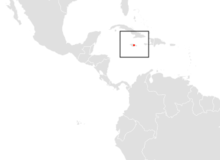Jamaica flowering bat
| Jamaica flowering bat | ||||||||||||
|---|---|---|---|---|---|---|---|---|---|---|---|---|
| Systematics | ||||||||||||
|
||||||||||||
| Scientific name | ||||||||||||
| Phyllonycteris aphylla | ||||||||||||
| ( Miller , 1898) |
| 2 | · | 1 | · | 2 | · | 3 | = 32 |
The Jamaican blossom bat ( Phyllonycteris aphylla ) is a mammal in the subfamily of the Antilles blossom bats (Phyllonycterinae).
features
The holotype described by Gerrit Smith Miller had a total length of 88 mm, including a 12 mm long tail, half of which was embedded in the tail membrane. The specimen had 48 mm long forearms, 17 mm long hind feet and 13 mm long ears. The nasal blade of this type does not have a leaf-shaped attachment and only consists of a round disc. The Jamaican flower bat has no calcar on its foot and its brown ears are not connected to one another. The flight membranes are colored brown. Furthermore, the species is characterized by a robust lower jaw and a broad tongue with numerous stiff papillae. The hair of the short coat is about 6 mm long on the top, while the underside is covered with hair about 4 mm long. The fur is yellow-brown in color all over the body. Individual specimens from a study published by Hugh H. Genoways and fellow researchers in 2005 weighed between 13.3 and 19 g.
Distribution and way of life
The Jamaican blossom bat is endemic to Jamaica and lives there in the vicinity of two caves ( Marta Tick Cave and Stony Hill Cave ), previously it was known from around half a dozen caves.
The species forms colonies with other bats in the caves. It feeds on fruits, nectar and pollen, and presumably on insects. Pregnant females were recorded in January and June, suggesting that females are ready to mate several times a year. One of the females was pregnant with an embryo .
status
For a long time after the first description of the species, only semi-fossil remains of the Jamaican blossom bat could be found in the known caves. This led to the belief in the early 1950s that the species was extinct. An intensive search in the following period was the first time a living specimen was found in Jamaica in 1957. According to an estimate by the IUCN (2015), the total population consists of 250 or fewer reproductive specimens. The bat is sensitive to disturbances in the resting place. In addition, the individuals can fall prey to stray domestic cats. The Jamaican flower bat is listed as Critically Endangered .
Individual evidence
- ↑ Don E. Wilson , DeeAnn M. Reeder (Ed.): Mammal Species of the World . A taxonomic and geographic Reference . 3. Edition. 2 volumes. Johns Hopkins University Press, Baltimore MD 2005, ISBN 0-8018-8221-4 (English, Phyllonycteris (Reithronycteris) aphylla ).
- ↑ Gerrit Smith Miller (1898) Descriptions of Five New Phyllostome Bats (PDF). Proceedings of the Academy of Natural Sciences of Philadelphia , pp. 333-337
- ↑ a b c Genoways HH, Baker RJ, Bickham JW & Phillips CJ (2005) Bats of Jamaica (PDF). Special Publications of the Museum of Texas Tech University , pp. 64-69
- ↑ a b c Phyllonycteris aphylla in the endangered Red List species the IUCN 2016 Posted by: Koenig, S. & Davalos, L., 2015. Accessed September 23, 2017th
